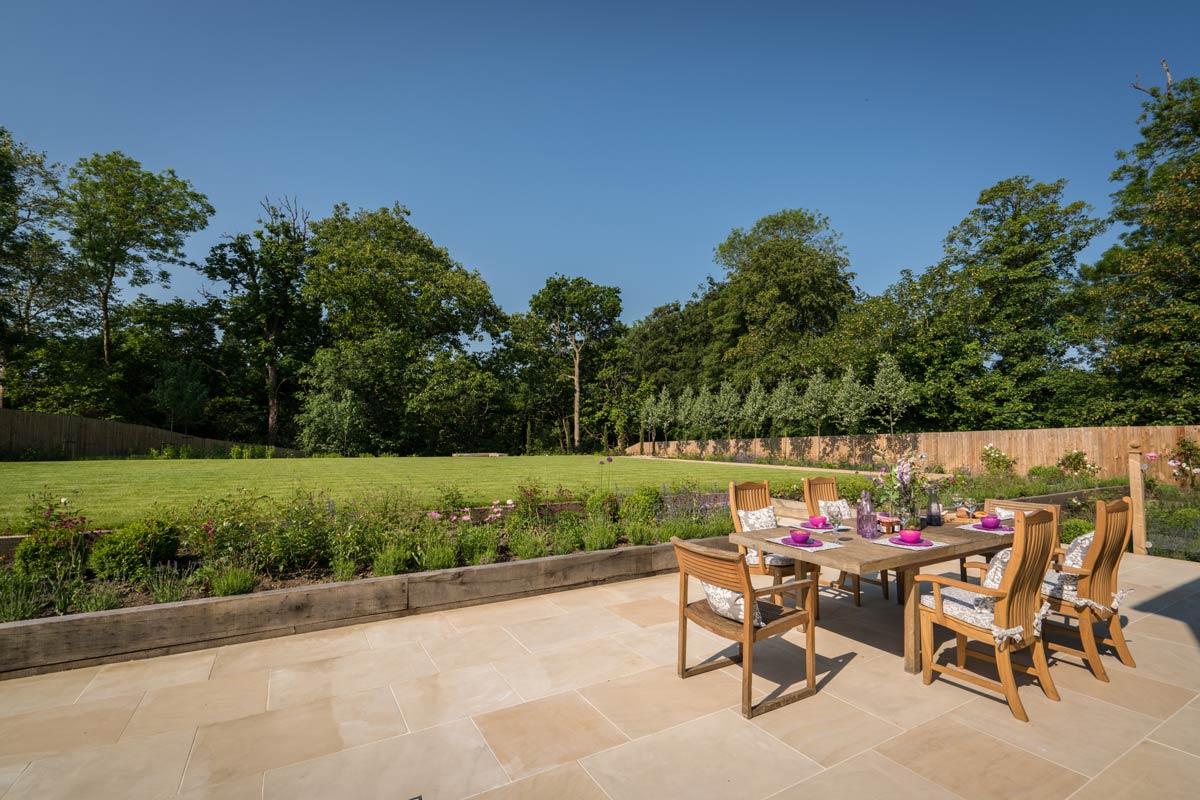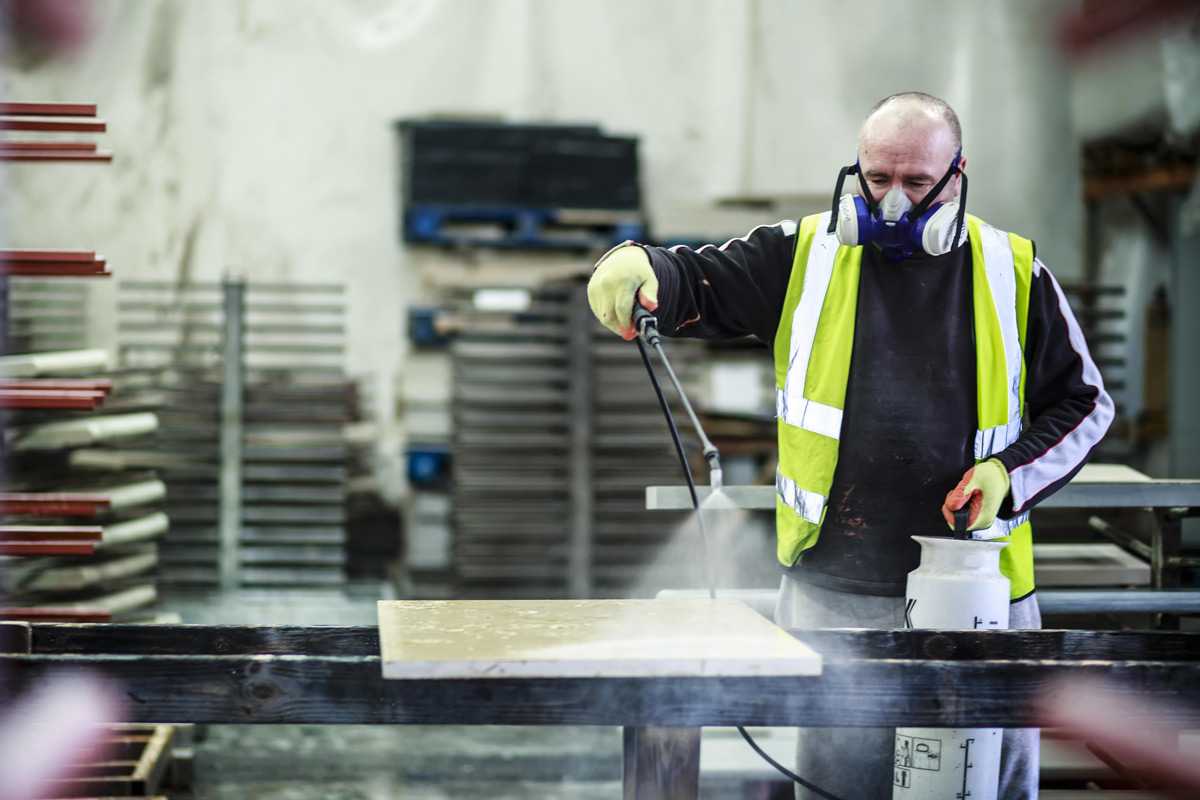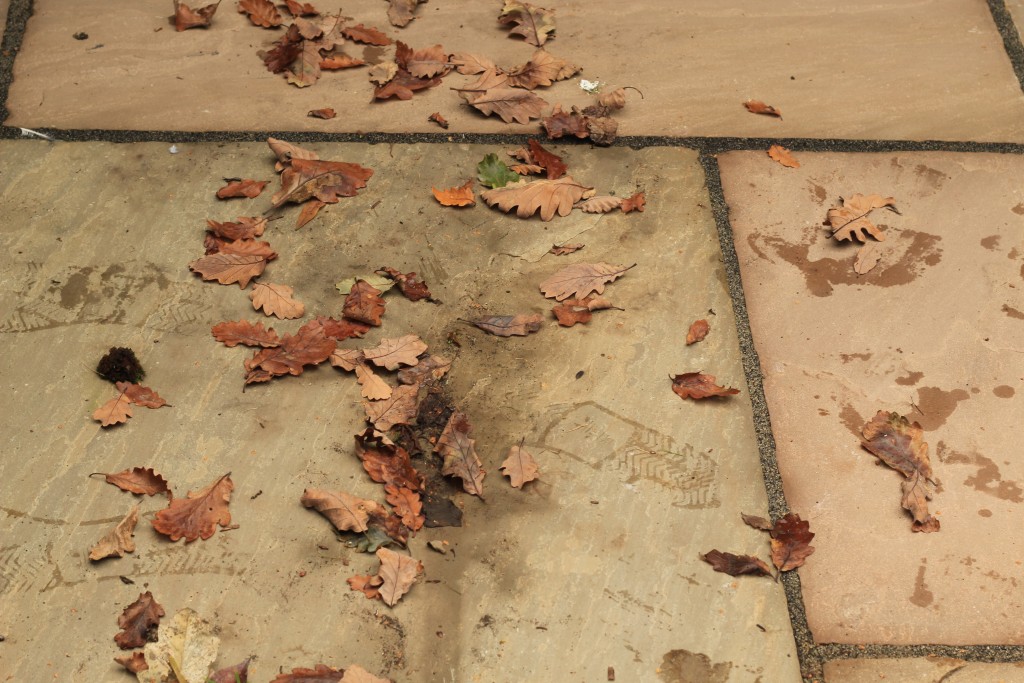At London Stone we know a thing or two about sealing and pre-sealing. We have put together this handy information so that you can decide whether you should seal your natural stone or porcelain paving.
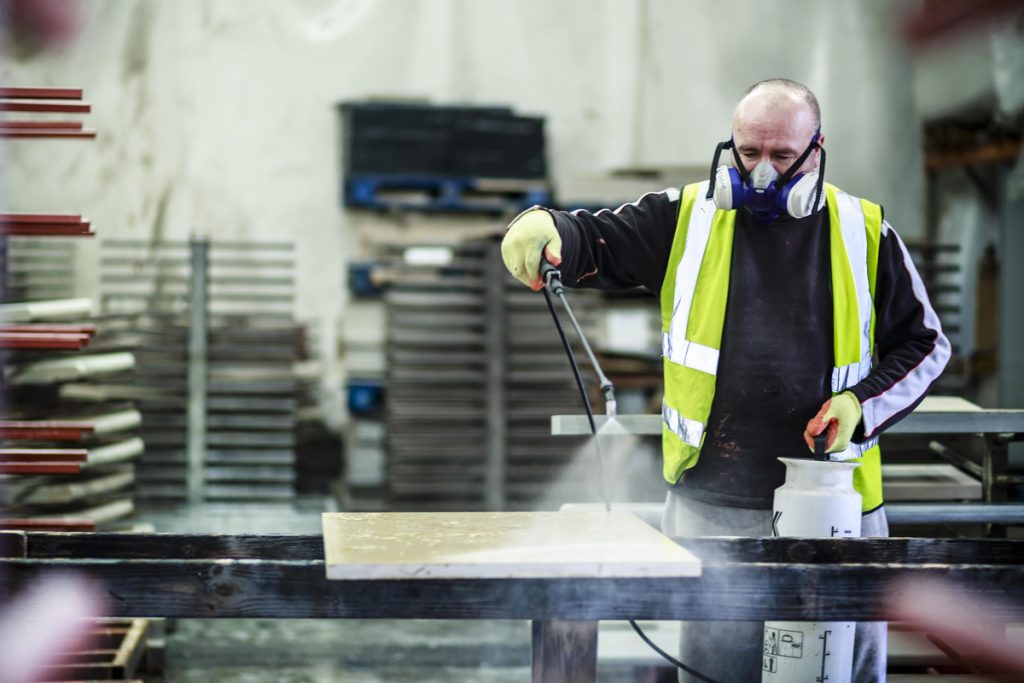
Should you seal sandstone and limestone paving?
Strictly speaking, no stone - sandstone, limestone, or any other - needs sealing or pre-sealing. (Pre-sealing is when the paving has sealant applied before delivery.) However, modern demands have changed. We often expect our paving to perform differently from before. Contemporary garden styles often demand pristine, un-weathered paving, and we want our natural stone to compete successfully with porcelain in terms of ease of maintenance.
Sawn sandstone and limestone
When it comes to sawn sandstone and limestone we strongly recommend sealing. This is because sawing opens up pores in the surface of natural stone, which increases its ability to absorb moisture. Moisture carries dirt with it and its absorption ups the need for maintenance.
Riven and dense stone paving
Depending on location, colour and personal preference, even riven stone and hard dense paving like granite or slate can benefit from sealing. For example, natural stone paving and north-facing gardens are not the best combination in the world. Usually we would say that riven paving doesn't need to be sealed, but if you do have a north-facing garden, we would advise it. North-facing gardens can be damp at the best of times, but in winter they can become sodden with water. The pores of natural stone paving are the perfect breeding ground for algae. Sealing paving will massively reduce algal growth.
Does porcelain paving need to be sealed?
Porcelain is already a hard-wearing material, and there is no necessity to seal it. However, as with riven sandstone and limestone, there are circumstances where you might find it an advantage to seal porcelain paving. Light-coloured paving that receives plenty of foot traffic, driveways, paving under dense foliage with plenty of leaf fall - all of these might need frequent cleaning. While a jet wash or a good stiff brush and water are usually enough to give porcelain back its pristine appearance, a sealant will make cleaning a little quicker and easier.
A Dry Treat sealer has been developed specifically for surfaces with low absorption rates. Find out more in our rundown of the best paving sealers for your patio.
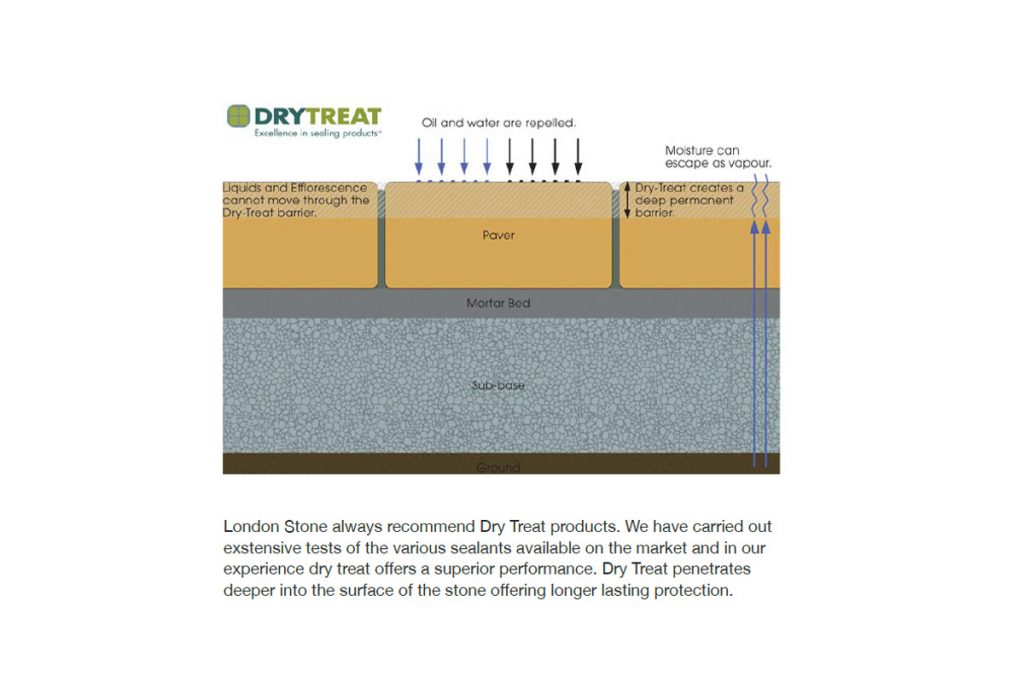
What type of paving sealant?
There are two types of paving sealer, each with their own pros and cons:
Traditional Topical Sealant (a coating that sits on the surface of the stone)
Pros
- Impervious to liquids
- Cheaper
- Provides a good short-term solution
- Needs to be reapplied
Cons
- Prevents moisture from escaping
- Mould can build up underneath the sealant
- Efflorescence can be trapped in the stone
- Changes slip resistance – especially when wet
- Changes appearance of stone and can leave stone looking shiny
- Wears quickly under traffic and UV light
- Needs stripping and reapplying
Impregnating Sealant (a solution that penetrates stone)
Pros
- Allows stone to breathe – pores of stone are left open
- Moisture can escape as vapour
- Slip resistance is not affected
- Appearance of the stone is not affected
- Forms a longer bond with the stone. Where Dry Treat is used, the bond is permanent and Dry Treat does not need to be re-applied
Cons
- Initial investment is more expensive.
Although, impregnating sealant is more expensive initially, we always recommend it over a topical sealant. This is because it only needs to be applied once, allows paving to breathe (which means that moisture cannot be trapped within the stone) and does not affect the properties or colour of the paving.
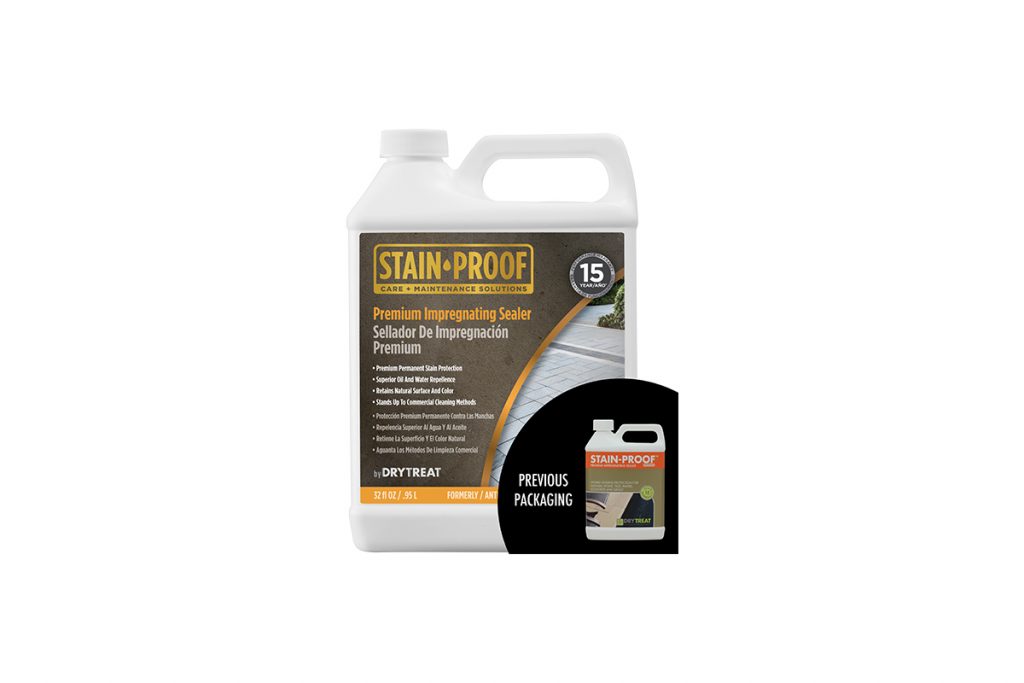
Stain Proof - our preferred choice
For our in-house pre-sealing service, we always use Dry Treat’s Stain Proof impregnating sealant, and this is what we recommend to use yourself for sealing sandstone, limestone and other paving. A premium water- and oil-repellent, it has deep-penetrating, permanent bonding technology for long-lasting, superior stain protection.
Equally suitable for indoor and outdoor, residential and commercial use, the sealant is super-breathable and stands up to alkaline cleaners and pressure hosing, making the stone easier to clean. Also Stain Proof, unlike other sealants, will retain the natural surface colour and finish of stone paving. It will delay the onset of algae, greatly reduce or stop efflorescence occurring, and can prevent picture framing.
Find out more about Dry Treat in our guide to the best paving sealants.
Do I need to seal all sides of the stone?
No, just the top surface. Dry Treat will penetrate the stone 4-6mm.
If the bottom is sealed, a sand and cement mortar will not bond to the slab. This is because the key to slabs bonding with the mortar bed is that water from the bedding layer is absorbed into the paving. If the underside of the paving is sealed, adhesion between bedding layer and slabs will be compromised, owing to the water repellence of the sealer.
When should you seal your paving?
The best option is to have your paving pre-sealed
This is carried out in a dry, clean, and controlled environment so you can be sure of good results. We are accredited operators for Dry Treat sealants, and a warranty is available on request. Pre-sealing will also help to keep the stone clean during installation. For more information on having your paving pre-sealed.
The next best choice is to seal on site, before installation
This application method is not complex but needs to be followed precisely or problems can occur. You will also require enough space to seal. This method will help to keep the stone clean during installation. See our Quick Guide to Sealing Natural Stone.
The third option is to seal after installation
Again, the application process is not complex but must be followed precisely. You should ideally seal before pointing. This method is, however, weather dependent, which can be difficult in the UK climate.
In order for natural stone sealant to work properly it needs to be applied in dry and, ideally, warm conditions. Over winter especially, these conditions can't be guaranteed and, even though paving may look dry, it could be very damp inside. If sealant is applied in these conditions, it will simply fail, resulting in unsightly white blooming on the surface of the stone.
If the paving is already laid and pointed, it's not the end of the world. Leave sealing till winter is well and truly past. It might get messy over the colder months but, when better conditions arrive, clean and seal the stone.
Why has water stopped beading on my paving?
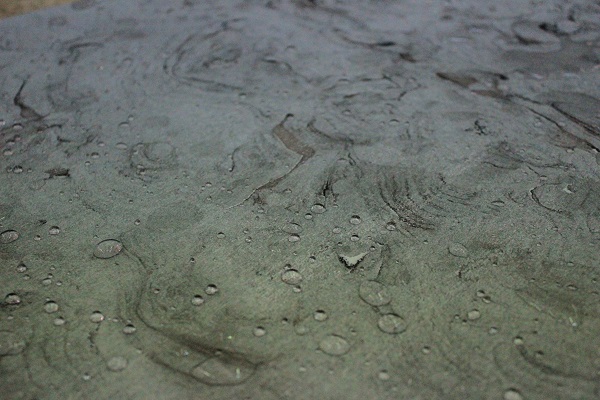
It’s worth knowing that when stone is first sealed, water will bead on the surface. This effect is down to a layer of sealant being left on the surface. This wears off over a short time.
If water is no longer beading on the surface of your paving, it does not mean that the sealant has failed. It is a natural stage in the curing of the patio slab sealer, when water will puddle on top of the paving instead, and will not seep into the stone.
I've sealed my patio. Why does it look dirty?
External stone has quite a textured surface for an improved slip-rating, which will inevitably collect dirt more easily. A sealer will make the surface water-, oil-, and stain-resistant, but even an impregnating sealant won’t make it dirt-proof! Sealing does, however, reduce how dirty it becomes. It also makes it much easier to clean that reduced level of dirt off it.
Leaf marks are one of the most common problems, with leaf sap/tannins left on the stone, which look almost like rust marks. Furniture can also leave rust marks, and food will fall from barbecues. Sealing ensures that these marks are removable and do not become ingrained in a way that makes them impossible to get rid of.
Most marks can be removed with the correct cleaning agent, but occasionally multiple chemicals may be necessary to break down different layers of grime.
Find out more about looking after your patio.
How soon can I jet wash my newly sealed stone?
Don't be tempted to clean your paving with a jet wash stone within the first four weeks after sealing. Yes, the paving is weather-proof after around eight hours, but Dry Treat Stain Proof takes around 4 weeks to migrate into the stone and fully cure.
Pressure washing before the sealant has fully cured is likely to damage the bond it creates with the stone. There's a significant danger that you'll force water into the pores of the stone, affect the sealant and permanently reduce its ability to do its job.
It is also worth noting that natural stone itself can be damaged by pressure washing. We don't recommend jet washing natural stone at all, but we know people like to do it, so it's important to jet wash correctly. If the surface of the stone is damaged, the sealant may become compromised.
Cleaning and maintenance
Any outdoor paving needs maintenance and cleaning; this includes sealed stone and porcelain. Along with a stiff deck brush and emulsifying pad, you will need cleaning agents to break the bond of the dirt with the stone and the physical action of a brush/emulsifying pad to lift the bond the dirt has created. Imagine you are washing a car—you would not just use water but also a car shampoo to clean. Use the correct cleaning agent for the dirt/substance being removed.
A jet wash can be used to remove the dirt from the surface, but must be used correctly—on a low setting and held away from the stone.
Which chemical should you use for which kind of stains?
Sealing makes paving stain-resistant, but they can still happen, especially if substances are left to lie. For more information, read our guide to cleaning products for paving.
We hope we've covered all your questions on pre-sealing and sealing sandstone, limestone and other paving materials. If you have any further questions, please do not hesitate to speak to one of our sales team.
Post updated: June 2023


/filters:quality(40)/mediadev/media/homepage/price_right_arrow.svg)
/filters:quality(60)/mediadev/media/menu-pics/menu_banner_mobile.png )
/filters:quality(60)/mediadev/media/menu-pics/all-porcelain.jpg )
/filters:quality(60)/mediadev/media/menu-pics/luxury-italian.jpg )
/filters:quality(60)/mediadev/media/menu-pics/premium-italian.jpg )
/filters:quality(60)/mediadev/media/menu-pics/budget-porcelain.jpg )
/filters:quality(60)/mediadev/media/menu-pics/large-format-porcelain.jpg )
/filters:quality(60)/mediadev/media/menu-pics/wood-effect-porcelain.jpg )
/filters:quality(60)/mediadev/media/menu-pics/porcelain-planks.jpg )
/filters:quality(60)/mediadev/media/menu-pics/porcelain-setts.jpg )
/filters:quality(60)/mediadev/media/menu-pics/browse-all-paving.jpg )
/filters:quality(60)/mediadev/media/menu-pics/stone-paving.jpg )
/filters:quality(60)/mediadev/media/menu-pics/interior-tiles.jpg )
/filters:quality(60)/mediadev/media/menu-pics/stone-effect-porcelain.png )
/filters:quality(60)/mediadev/media/menu-pics/wood-effect-porcelain.png )
/filters:quality(60)/mediadev/media/menu-pics/grey-porcelain.png )
/filters:quality(60)/mediadev/media/menu-pics/beige-porcelain.png )
/filters:quality(60)/mediadev/media/menu-pics/dark-porcelain.png )
/filters:quality(60)/mediadev/media/menu-pics/light-porcelain.png )
/filters:quality(60)/mediadev/media/menu-pics/patio-grout.jpg)
/filters:quality(60)/mediadev/media/menu-pics/primers.jpg)
/filters:quality(60)/mediadev/media/menu-pics/porcelain-blades.jpg)
/filters:quality(90)/mediadev/media/menu-pics/drainage.jpg)
/filters:quality(60)/mediadev/media/menu-pics/cleaners.jpg)
/filters:quality(60)/mediadev/media/menu-pics/all-stone-paving.jpg )
/filters:quality(60)/mediadev/media/menu-pics/all-sawn-paving.jpg )
/filters:quality(60)/mediadev/media/menu-pics/all-riven-paving.jpg )
/filters:quality(60)/mediadev/media/menu-pics/indian-sandstone.jpg )
/filters:quality(60)/mediadev/media/menu-pics/limestone-paving.jpg )
/filters:quality(60)/mediadev/media/menu-pics/granite-paving.jpg )
/filters:quality(60)/mediadev/media/menu-pics/slate-paving.jpg )
/filters:quality(60)/mediadev/media/menu-pics/yorkstone-paving.jpg )
/filters:quality(60)/mediadev/media/menu-pics/stone-pavers.jpg )
/filters:quality(60)/mediadev/media/menu-pics/cobbles-setts.jpg )
/filters:quality(60)/mediadev/media/menu-pics/plank-paving.jpg )
/filters:quality(60)/mediadev/media/menu-pics/paving-circles.jpg )
/filters:quality(60)/mediadev/media/menu-pics/bespoke-paving-1.jpg )
/filters:quality(60)/mediadev/media/menu-pics/edging-stones-1.jpg )
/filters:quality(60)/mediadev/media/menu-pics/prestige-stone.jpg )
/filters:quality(60)/mediadev/media/menu-pics/grey-blue-stone.png)
/filters:quality(60)/mediadev/media/menu-pics/swatch-black-dark.jpg )
/filters:quality(60)/mediadev/media/menu-pics/swatch-buff-beige-white.jpg )
/filters:quality(60)/mediadev/media/menu-pics/sealants.jpg)
/filters:quality(60)/mediadev/media/menu-pics/all-clay-paving.jpg )
/filters:quality(60)/mediadev/media/menu-pics/alpha-clay-pavers.jpg )
/filters:quality(60)/mediadev/media/menu-pics/cottage-garden-clay-pavers.jpg )
/filters:quality(60)/mediadev/media/menu-pics/kessel-garden-clay-pavers.jpg )
/filters:quality(60)/mediadev/media/menu-pics/artisan-clay-pavers.jpg )
/filters:quality(60)/mediadev/media/menu-pics/grey-blue-clay-paver.png )
/filters:quality(60)/mediadev/media/menu-pics/red-brown-clay-pavers.png )
/filters:quality(60)/mediadev/media/menu-pics/beige-buff-clay-pavers.png )
/filters:quality(60)/mediadev/media/menu-pics/composite-decking.jpg )
/filters:quality(60)/mediadev/media/menu-pics/designboard-decking.jpg )
/filters:quality(60)/mediadev/media/menu-pics/classic-designboard.jpg )
/filters:quality(60)/mediadev/media/menu-pics/brushed-designboard.jpg )
/filters:quality(60)/mediadev/media/menu-pics/grooved-designboard.jpg )
/filters:quality(60)/mediadev/media/menu-pics/millboard-decking.jpg )
/filters:quality(60)/mediadev/media/menu-pics/grey-decking.jpg )
/filters:quality(60)/mediadev/media/menu-pics/black-charcoal-decking.jpg)
/filters:quality(60)/mediadev/media/menu-pics/brown-decking.jpg)
/filters:quality(60)/mediadev/media/menu-pics/all-build-deck.png )
/filters:quality(60)/mediadev/media/menu-pics/stone-cladding.jpg )
/filters:quality(60)/mediadev/media/menu-pics/all-garden-walling-1.jpg )
/filters:quality(60)/mediadev/media/menu-pics/facing-bricks.jpg )
/filters:quality(60)/mediadev/media/menu-pics/garden-screening.jpg )
/filters:quality(60)/mediadev/media/menu-pics/menu_Garden_banner_desk.png )
/filters:quality(60)/mediadev/media/menu-pics/all-steps-coping.jpg )
/filters:quality(60)/mediadev/media/menu-pics/stone-garden-steps.jpg )
/filters:quality(60)/mediadev/media/menu-pics/sawn-steps.jpg )
/filters:quality(60)/mediadev/media/menu-pics/riven-steps.jpg )
/filters:quality(60)/mediadev/media/menu-pics/yorkstone-steps.jpg )
/filters:quality(60)/mediadev/media/menu-pics/bespoke-steps.jpg )
/filters:quality(60)/mediadev/media/menu-pics/porcelain-steps.jpg )
/filters:quality(60)/mediadev/media/menu-pics/off-the-shelf.jpg )
/filters:quality(60)/mediadev/media/menu-pics/stone-coping.jpg )
/filters:quality(60)/mediadev/media/menu-pics/sawn-coping.jpg )
/filters:quality(60)/mediadev/media/menu-pics/riven-coping.jpg )
/filters:quality(60)/mediadev/media/menu-pics/yorkstone-coping.jpg )
/filters:quality(60)/mediadev/media/menu-pics/bespoke-coping.jpg )
/filters:quality(60)/mediadev/media/menu-pics/stone-pier-caps.jpg )
/filters:quality(60)/mediadev/media/menu-pics/porcelain-coping.jpg )
/filters:quality(60)/mediadev/media/menu-pics/all-bespoke-services.jpg )
/filters:quality(60)/mediadev/media/menu-pics/bespoke-paving-2.jpg )
/filters:quality(60)/mediadev/media/menu-pics/bespoke-steps-1.jpg )
/filters:quality(60)/mediadev/media/menu-pics/bespoke-coping-1.jpg )
/filters:quality(60)/mediadev/media/menu-pics/edge-profiles.jpg )
/filters:quality(60)/mediadev/media/menu-pics/masonry-services.jpg )
/filters:quality(60)/mediadev/media/menu-pics/deluxe-pergolas.jpg )
/filters:quality(60)/mediadev/media/menu-pics/proteus-pergolas.jpg )
/filters:quality(60)/mediadev/media/menu-pics/corten_planter_menu.png )
 Trade Discount Available
Trade Discount Available FREE Nationwide Delivery
FREE Nationwide Delivery Nationwide Showrooms
Nationwide Showrooms Live Stock Levels
Live Stock Levels Split Packs Available
Split Packs Available